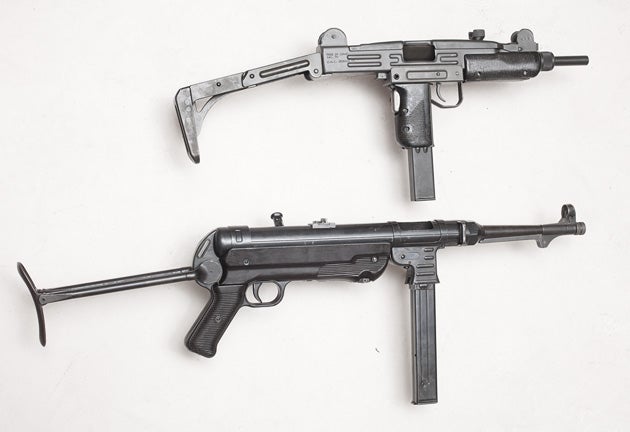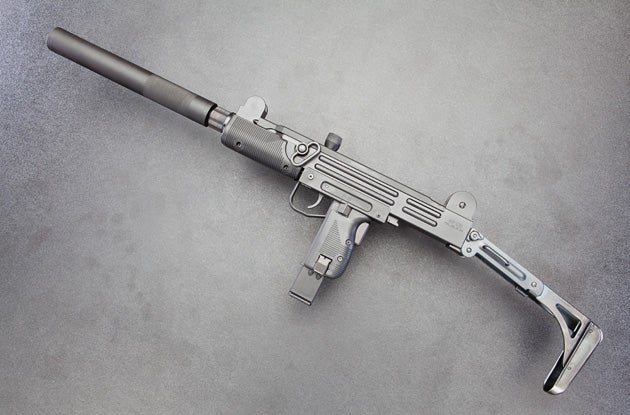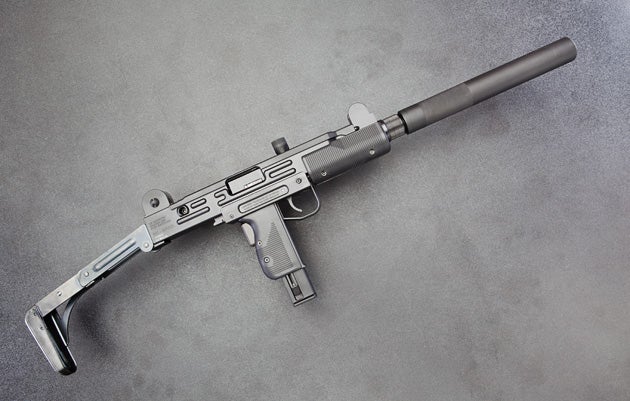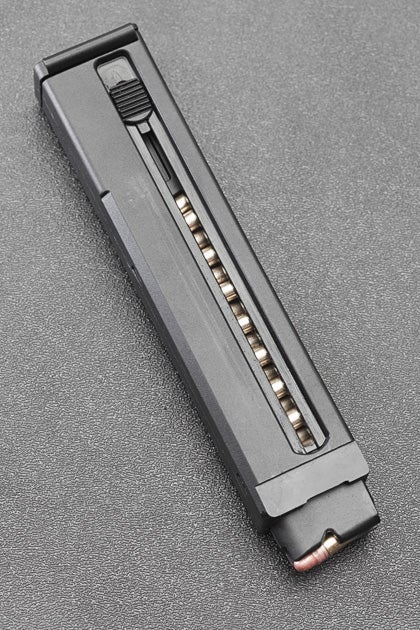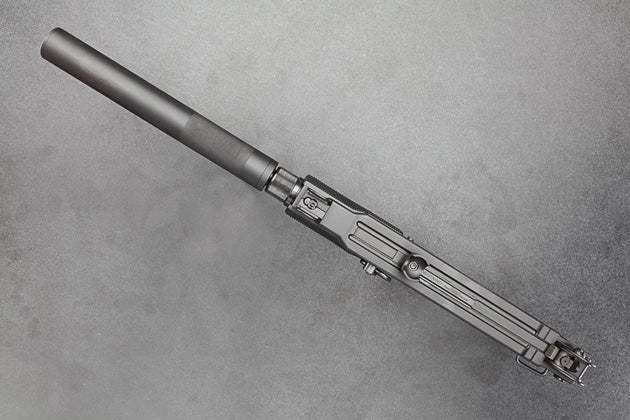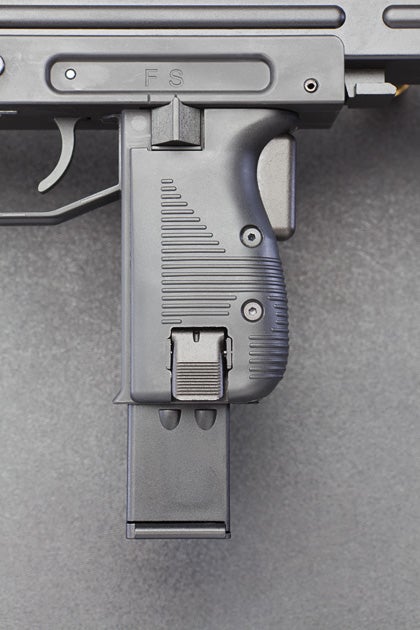IWI Uzi .22 rifle
Oleg Volk 09.16.13

The Uzi .22 carbine made by Walther looks like a sound-suppressed Uzi 9mm submachine gun. I tried it at SHOT Show range day and was immediately interested. It’s a very close copy of the original in some ways and completely dissimilar in others. Is it worth having? Let’s look at the details.
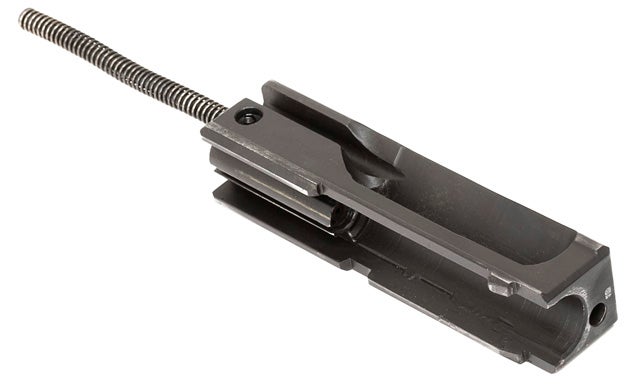
The original Uzi submachine gun was adopted by Israel in the mid-1950s. The magazine fit through the pistol grip, giving the gun a distinctive appearance. Loosely based on Czechoslovak Sa.23 through Sa.26 designs, Uzi used an enveloping bolt layout to reduce the length of the receiver. This arrangement allows a drastic reduction in length of the whole gun relative to the WW2 designs like the MP40 shown below.
Also unlike most WW2 designs, Uzi had a rebound safety that kept the bolt in place if the gun was jostled. Combined with a manual safe/semi/auto selector and a grip safety, that reduced the likelihood of accidental discharges. Unfortunately, because the magazine through the grip also dictated an awkward 90 degree angle, some IDF troops would tape down the grip safety in actual use.
Borrowing from auto cannon and submachine guns like the MP40 and K31 Suomi, Uzi uses advanced primer ignition open bolt blowback action. The bolt is held back by the sear before the first shot. Upon trigger pull, the bolt slams forward, pushes the top round from the magazine into the chamber and fires it a fraction of a second before coming to a full stop against the breechface. By having the recoil work against the forward inertia of the still-moving bolt, the gun achieves safe chambering and extraction with a lighter spring and bold weight than possible with straight blowback. Open bolt was typical for the submachine guns of the time: it was simple to make and allowed draft ventilation of the barrel through the open chamber. It also allowed the introduction of dust or sand into the magazine through the ejection port.
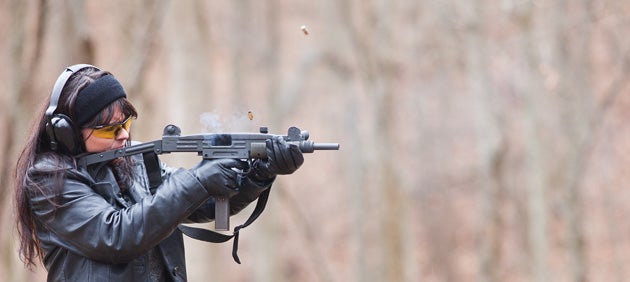
Designed for easy mass-production with heavy use of stampings, Uzi was eventually adopted by dozens of armies and institutions, and produced in 9mm, 41AE, 45ACP and .22LR. In the US, it was used for a while by the Secret Service. Because National Firearms Acts of 1934 and 1968 greatly restricted import and domestic production of submachine guns, they are not common in America. Until 1986, some could be converted from semi-automatic variants for private use. Most of the Uzis in private hands are Uzi B carbines — plain blowback closed bolt guns with 16 inch barrels as required to avoid “short barreled rifle” designation and the associated restrictions and excise taxes. And Uzi B looks awkward because of the long, skinny barrel. It still has the short sight radius of the original SMG.
Closed bolt design requires a much heavier recoil spring. On the plus side, accuracy in semi-automatic mode is greatly enhanced because only a lightweight striker moves prior to the shot. In the select-fire original, an entire bolt slams forward before every shot — and because it moves the center of balance from behind the grip to the front, the disturbance of aim is considerable. The shooter has to keep the muzzle from dipping before the shot, but also to keep it from rising on recoil immediately after. The lock time between the trigger pull and the actual shot is also vastly reduced in the civilian semi-auto variant, also aiding accuracy. Groups of 4 inches at 100 yards are not uncommon, while the open bolt guns require a great deal of practice to shoot even half as well. It’s mostly up close, at ranges under 25 yards, that the open bolt gun really shines. Even though open-bolt .22LR conversions of Uzi SMG exist for training, a close-bolt version makes more sense for the US market as semi-auto carbines dominate numerically. Enter the Walther licensed rimfire Uzi.
The only visual difference between the .22 and the 9mm is the magazine. Rimfire magazine holds 20 rounds and has a visible follower tab for ease of loading. 9mm magazines hold 25 or 32 rounds and have witness holes only. Loading them can be hard on the fingers despite the double feed design.
The thin 16 inch barrel is surrounded by a metal shroud resembling a sound suppressor. The shroud provides additional support for the barrel and a comfortable gripping surface for the support hand. The weight and the balance of the carbine are a close match to the centerfire version.
The sights are identical but set up for closer ranges (“under 25 meters” and “longer range” according to the manual, about 20 and 50 yards in reality). The folding stock works similarly to the 9mm version, as does the safety.
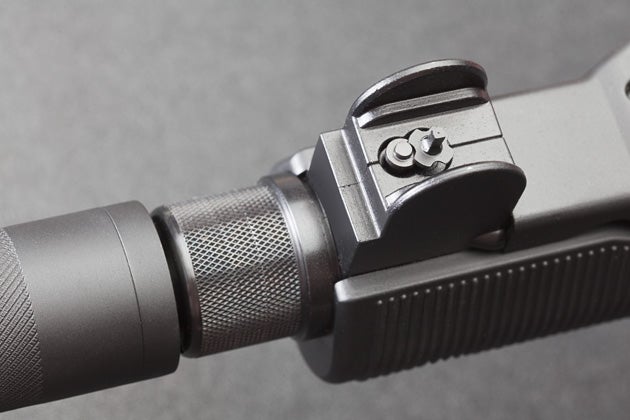
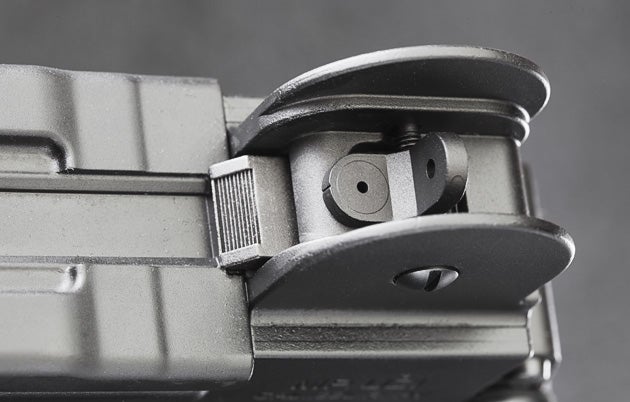
Internally, the .22 is much different, with a simple, non-enveloping bolt. It field-strips easily into three major parts for cleaning. The barrel does not detach. Unlike the .22 select-fire SMG, this is a completely different firearm designed to the same form factor and almost the same manual of arms.
Recoil is obviously nonexistent. The stock remains a bit long for smaller users, but that can be accommodated with a bladed stance. The un-suppressed report isn’t much louder than suppressed 9mm firing supersonic ammunition.
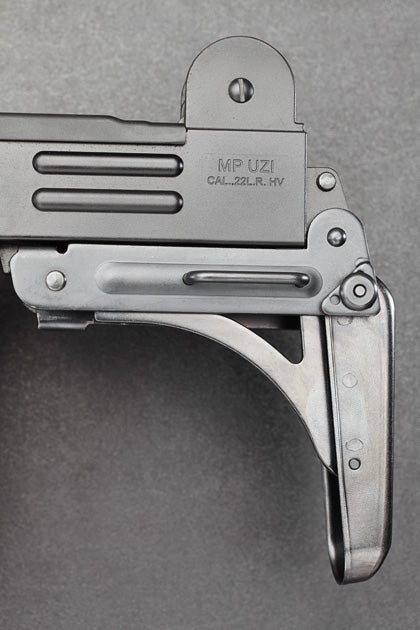
The carbine is labeled “22LR HV” to indicate that only high-velocity ammunition is guaranteed to cycle reliably. CCI Mini Mag or similar ammunition is recommended.
The main limitation on accuracy are the sights which are relatively close to each other. At 50 yards, 3-4 inch groups are typical from a carbine supported on sandbags. The .22 Uzi shines at a very different task — close-range reactive shooting that usually consumes copious amounts of ammunition.
With the perfect weight and size imitation of the 9mm gun, this .22 is an excellent and realistic training tool, especially if you own an Uzi B carbine. It can be as much fun to run as the SMG because the shooter can pay more attention to the situation and less to wrestling the lurching open bolt weapon back on target.
